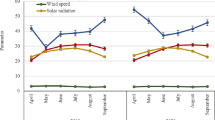Abstract
Early-maturing soybean lines (Glycine max (L.) Merr.) grown in subtropical areas during short days can produce economic seed yields. However, the plants are short, and many of the pods are produced close to the soil, making commercial harvest difficult. The feasibility of increasing the lengths of the first three internodes by growth regulator application was evaluated at two locations over a 3-year period using separate plots of Amsoy 71 (Maturity Group (MG) II) and Williams (MG III) soybean by spraying each cultivar with 0, 25, or 50 g (a.i.) ha−1 of gibberellic acid (GA) in 280 L ha−1 water when the hypocotyl was cracking the soil. The 25 g ha−1 treatment increased (p<.05) the length of the hypocotyl and first internode 60% and 25% in 1979 and 36% and 17%, respectively, in 1980. Increasing the GA application to 50 g ha−1 had no additional effect on hypocotyl elongation, but the length of the first internode continued to increase linearly. Gibberellic acid treatment did not stimulate elongation of internodes above the first two, and internodes above the fifth tended to be shorter, causing total plant height at maturity to be the same as untreated plants. The overall effect of GA application at cracking time on harvestable seed yield was about nil, since GA decreased yields by 8–11%, but it increased stem elongation, so a greater portion of seeds were produced above 80 mm that were accessible to commercial combining. The application of GA generally did not affect (p<.05) seed quality. Seed weight was reduced significantly at both locations in 1979 but not in 1980. These data indicate that elongation of the lower stem portion of early-maturing soybean cultivars grown in subtropical areas during short days can be increased significantly by GA to improve commercial harvesting, but the treatments appear to have little net effect on seed yield.
Similar content being viewed by others
References
Bird LS, Ergle DR (1960) Seedling growth differences of several cotton varieties and the influence of gibberellin. Agron J 53:171–172
Boote KJ (1977) Production potential for early maturing soybean cultivars planted in March in Florida. Soil Crop Sci Soc Fla Proc 36:152–157
Boote KJ (1981) Response of soybeans in different maturity groups to March plantings in Southern USA. Agron J 73:854–859
Bradford WW, Ewing EC Jr (1958) Preliminary studies on the application of gibberellic acid to cotton seed and seedlings. Agron J 50:648–650
Howell RW, Wargel CJ, Brim CA, Hartwig EE, Lambert JW, Thompson JR, Stefansson BR, Park JK, Seigler WE, Webb BK (1960) Response of soybean to seed-treatment with gibberellin under simulated commercial conditions. Agron J 53:144–146
Author information
Authors and Affiliations
Rights and permissions
About this article
Cite this article
Mislevy, P., Boote, K.J. & Martin, F.G. Soybean response to gibberellic acid treatments. J Plant Growth Regul 8, 11–18 (1989). https://doi.org/10.1007/BF02024922
Received:
Accepted:
Issue Date:
DOI: https://doi.org/10.1007/BF02024922




